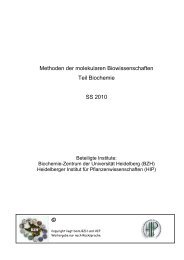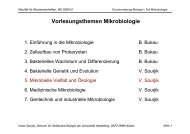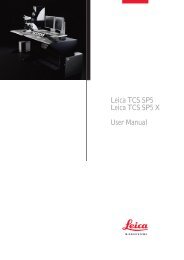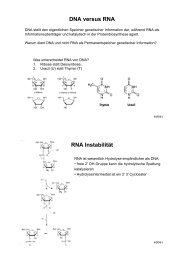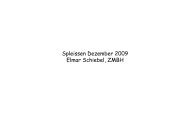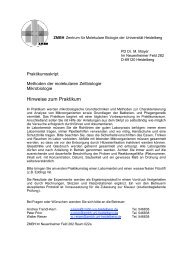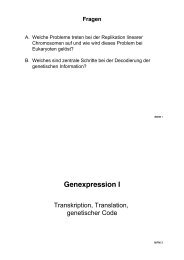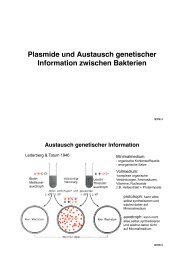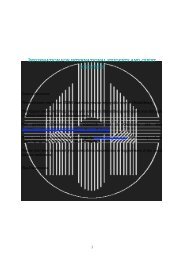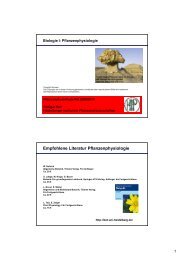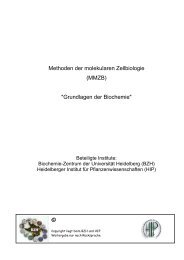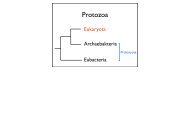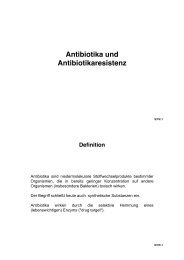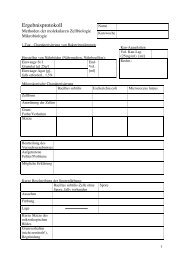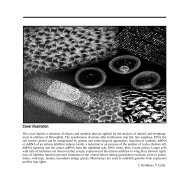ZMBH J.Bericht 2000 - Zentrum für Molekulare Biologie der ...
ZMBH J.Bericht 2000 - Zentrum für Molekulare Biologie der ...
ZMBH J.Bericht 2000 - Zentrum für Molekulare Biologie der ...
Create successful ePaper yourself
Turn your PDF publications into a flip-book with our unique Google optimized e-Paper software.
Biocomputing<br />
Computing and communication via the internet are<br />
absolutely essential for the mo<strong>der</strong>n biological Sciences.<br />
Accordingly, the <strong>ZMBH</strong> is equipped with a<br />
powerful computer network that comprises by now<br />
three central Macintosh Servers, ≈180 Macintoshs for<br />
endusers, two Sun workstations, 20 Windows com–<br />
puters and 20 printers that are connected with each<br />
other through an Ethernet and a Local talk system.<br />
A consi<strong>der</strong>able amount of computer-controlled equipment,<br />
such as microscopes, fluor- and phosphoimagers,<br />
oligonucleotide- and polypeptide synthesisers, as<br />
well as DNA-sequencing machines, are also integrated<br />
into the network.<br />
The <strong>ZMBH</strong> employs a team of three computer specialists,<br />
complemented by one or more students,<br />
who maintain and up-date the hardware and software<br />
and give a comprehensive support to all users. This<br />
includes, for example, administration of the network<br />
and servers, set up of computers according to the<br />
individual user‘s requirements and the creation of<br />
customised databases for sophisticated, user-specific<br />
sequence analysis with UNIX-based software. In addition,<br />
the computer group provides software training<br />
in small groups or on an individual basis for a broad<br />
range of applications.<br />
140<br />
Raphael Mosbach<br />
Animal House and Transgene Lab 1<br />
The <strong>ZMBH</strong> animal house is a central division of the<br />
institute that provides research groups with the opportunity<br />
to breed experimental animals and perform<br />
animal experiments. For this purpose, the animal house<br />
maintains quantities of mice, rats, rabbits and African<br />
clawed toads (Xenopus laevis).<br />
Covering a total area of 560 m 2 there are rooms for<br />
housing the animals, preparation rooms, storage areas<br />
and a large enclosure with cage-washing facilities and<br />
autoclave. The animal house is run as a SPF-unit. That<br />
is to say, the animals are kept un<strong>der</strong> conditions that are<br />
strictly isolated from the outside environment. Careful<br />
controls ensure that animals introduced into the facility<br />
are free of any of the pathogens typically found in<br />
the species.<br />
Experimental protocols indicating immunizations,<br />
blood samplings etc. are performed by the animal<br />
house staff as a service to the research groups. Methods<br />
employed, for example, for treatment applications,<br />
body fluid samplings and surgery, adhere to contemporary<br />
standards in experimental animal science. Moreover<br />
the methods used are un<strong>der</strong> continuous assessment<br />
and improved techniques are introduced whenever<br />
possible.<br />
The Transgene-Laboratory offers the generation of<br />
transgenic mice and rats and mouse-chimeras, as well<br />
as offering in-vitro-fertilization, ovary-transfer and<br />
cryopreservation of embryos of both species. During<br />
1998/99 224 pronucleus- and ES-cell-injections were<br />
performed with mice, which delivered a total of over<br />
1.300 foun<strong>der</strong>s and chimeras respectively - an average<br />
of 6 positive animals per experiment. Also, 49<br />
transgenic mouse lines were cryopreserved, and 2 lines<br />
were revitalized. Finally, 2 invitro-fertilizations were<br />
performed and 11 microbilogically contaminated lines<br />
from other facilities were re<strong>der</strong>ived by embryotransfer.<br />
Moreover, courses on transgenic techniques and reproductive<br />
biology were held for graduate students, and<br />
special training programs were offered for transgene<br />
technicians.<br />
1 For more information use the link „Biogroup“ of the <strong>ZMBH</strong>-homepage<br />
Jürgen Weiß<br />
Teaching Facilities<br />
The <strong>ZMBH</strong> has invested consi<strong>der</strong>able funds and effort<br />
in building and maintaining adequate facilities for<br />
student laboratory courses in molecular biology, cell<br />
biology, biochemistry and microbiology. This teaching<br />
facility is organized as an independent unit consisting<br />
of a laboratory providing space for 14 students,<br />
with labs for special equipment, a darkroom and a<br />
kitchen for cleaning glassware and for media preparation.<br />
Major equipment includes: scintillation counters,<br />
spectrophotometers, ultracentrifuges and computers.<br />
In addition, there is all the equipment required<br />
for work with radioactive compounds and biological<br />
materials at the S1 safety level. The facilities are<br />
scheduled each year for the 10 months of the regular<br />
curriculum of the Faculty of Biology. For the remaining<br />
time, the laboratory is used for postgraduate training.<br />
Our teaching secretariat provides administrative support<br />
to all the teaching activities and to the development<br />
of curricula. It also keeps records of all <strong>ZMBH</strong><br />
students.<br />
In the academic year 1998/99 we had some 80 graduates<br />
and around 300 un<strong>der</strong>graduates participating in<br />
the institute‘s programs in molecular biology and cell<br />
biology. These two programs have been chosen by<br />
70% of the biology students after their „Vordiplom“ in<br />
1998/1999.<br />
Hans Peter Blaschkowski<br />
Richard Herrmann<br />
141



